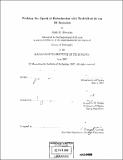Probing the epoch of reionization with redshifted 21 cm HI emission
Author(s)
Bowman, Judd D. (Judd David)
DownloadFull printable version (37.96Mb)
Other Contributors
Massachusetts Institute of Technology. Dept. of Physics.
Advisor
Jacqueline N. Hewitt.
Terms of use
Metadata
Show full item recordAbstract
Emission and absorption features in the spectrum of the diffuse radio background below 200 MHz due to the 21 cm hyperfine transition line of neutral hydrogen gas in the high redshift intergalactic medium offer a new and potentially valuable probe into the evolution of the Universe during the poorly constrained period when the first stars, galaxies, and quasars formed between approximately 370,000 to 700 million years after the Big Bang. We place an initial upper limit of 450 mK on the relative brightness temperature of the redshifted 21 cm contribution to the all-sky spectrum, assuming a rapid transition to a fully ionized intergalactic medium at a redshift of 8. This limit is approximately a factor of 20 greater than the expected contribution of 25 to 35 mK. We analyze the ability of a new class of interferometric radio arrays to measure the statistical properties of expected angular and spectral fluctuations in the diffuse redshifted 21 cm emission. We calculate that thermal noise should not prevent the Mileura Widefield Array (MWA) from detecting the power spectrum of the fluctuations between redshifts 6 and 12, as long as the intergalactic medium is not fully ionized. Measurements of the redshifted 21 cm signal will be contaminated from intense Galactic synchrotron radiation and extragalactic continuum sources. We find that the instrumental response of the MWA does not prevent the spectral properties of the anticipated foregrounds from being used to separate the foregrounds from the redshifted 21 cm fluctuations in "dirty" sky maps. We also test whether observations with the MWA will be able to constrain the fundamental cosmological model if the hydrogen in the IGM remains fully neutral until redshift 8. The MWA cannot constrain the underlying cosmology, but a similar experiment with a 10-fold increase in collecting area could provide useful constraints on the slope of the inflationary power spectrum and the running of the spectral index. (cont.) Observations acquired during field tests with prototype equipment at the MWA's remote site in western Australia confirmed the predicted sensitivity of the antennas, sky-noise dominated system temperatures, and phase coherent interferometric measurements. The radio spectrum was found to be remarkably free of strong terrestrial signals between 80 and 300 MHz.
Description
Thesis (Ph. D.)--Massachusetts Institute of Technology, Dept. of Physics, 2007. Includes bibliographical references (p. 137-147).
Date issued
2007Department
Massachusetts Institute of Technology. Department of PhysicsPublisher
Massachusetts Institute of Technology
Keywords
Physics.